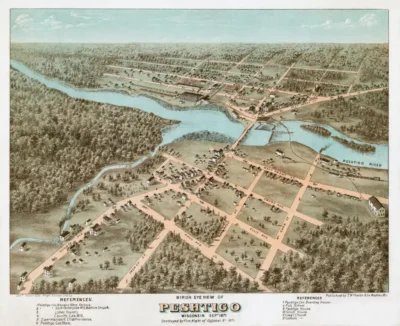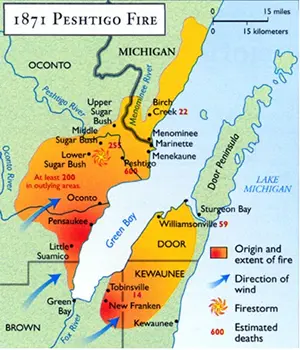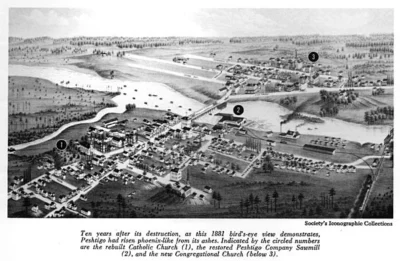
When Wisconsinites talk about wildfires, it’s often in reference to smoke traveling down from Canada or the West Coast. Being in the relatively humid Midwest, Wisconsin isn’t usually thought to be in danger of fires, yet the deadliest wildfire in America’s history occurred in northeastern Wisconsin.
On October 8 and 9, 1871, the thriving village of Peshtigo in Marinette County was demolished, and nearly half of its residents killed, as fire consumed the town.
Although four other large fires burned simultaneously across northern Michigan, this conflagration is now known as the Peshtigo Fire.
The Cause
Between July and September, a persistent ridge of high pressure extended from the central Plains into the Midwest. This led to warm and dry conditions across this region that extended into the fall season.
The forests of northeastern Wisconsin were being logged for timber at the time. Settlers were clearing land for agriculture and local industry. Wasteful land use practices meant that some timber was discarded and later burned to clear debris.
Very low relative humidity was reported during the week before the fire, which reduced the moisture content of dead logs, branches, and brush on the forest floor.
While the origin of the spark that started the wildfire has never been officially determined, it’s possible that it was a brush fire that got out of control. A volunteer weather observer just 60 miles southwest of Peshtigo reported seeing smoke from several ongoing local fires on October 8.
The weather conditions helped create the perfect storm that allowed the rapid spread of the fire on October 8. A low-pressure system was strengthening over Minnesota, while a high-pressure system was centered over the Southeast region of the U.S. The difference in pressure between the two systems became greater, causing strong southwest winds to blow over Wisconsin and Michigan.
By evening, strong winds fanned the smoldering fires. As the flames grew, a firestorm was created — a phenomenon that emerges when the heat from a large fire begins to create its own wind flow.

The Impacts
The firestorm scorched a swath of land 40 miles long and 10 miles wide across the county.
Peshtigo was consumed in less than two hours by the wall of fire. When the smoke had cleared, only two buildings remained. An estimated 800 village residents died.
The winds carried the embers across county borders. In Door County, the community of Williamsonville was consumed by a fire whirl, a tornado of flames created by the rising heat. Tornado Memorial County Park, where 60 fire fatalities are memorialized, now stands near the site.
In total, 16 towns were burned across Brown, Oconto, and Marinette Counties along the western side of the bay of Green Bay and in Door and Kewaunee Counties east of the bay.
Over one million acres were burned across northeast Wisconsin and the Upper Peninsula of Michigan. Between 1,200 and 2,500 people lost their lives, and thousands were left without homes.

This is a product of the Wisconsin State Climatology Office. For questions and comments, please contact us by email (stclim@aos.wisc.edu) or phone (608-263-2374).